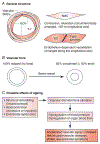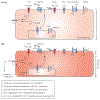Vascular calcium signalling and ageing
- PMID: 34705288
- PMCID: PMC9002240
- DOI: 10.1113/JP280950
Vascular calcium signalling and ageing
Abstract
Changes in cellular Ca2+ levels have major influences on vascular function and blood pressure regulation. Vascular smooth muscle cells (SMCs) and endothelial cells (ECs) orchestrate vascular activity in distinct ways, often involving highly specific fluctuations in Ca2+ signalling. Ageing is a major risk factor for cardiovascular diseases, but the impact of ageing per se on vascular Ca2+ signalling has received insufficient attention. We reviewed the literature for age-related changes in Ca2+ signalling in relation to vascular structure and function. Vascular tone dysregulation in several vascular beds has been linked to abnormal expression or activity of SMC voltage-gated Ca2+ channels, Ca2+ -activated K+ channels or TRPC6 channels. Some of these effects were linked to altered caveolae density, microRNA expression or 20-HETE abundance. Intracellular store Ca2+ handling was suppressed in ageing mainly via reduced expression of intracellular Ca2+ release channels, and Ca2+ reuptake or efflux pumps. An increase in mitochondrial Ca2+ uptake, leading to oxidative stress, could also play a role in SMC hypercontractility and structural remodelling in ageing. In ECs, ageing entailed diverse effects on spontaneous and evoked Ca2+ transients, as well as structural changes at the EC-SMC interface. The concerted effects of altered Ca2+ signalling on myogenic tone, endothelium-dependent vasodilatation, and vascular structure are likely to contribute to blood pressure dysregulation and blood flow distribution deficits in critical organs. With the increase in the world's ageing population, future studies should be directed at solving specific ageing-induced Ca2+ signalling deficits to combat the imminent accelerated vascular ageing and increased risk of cardiovascular diseases.
Keywords: ageing; blood flow dysregulation; calcium signalling; endothelium; hypertension; vascular dysfunction; vascular smooth muscle.
© 2021 The Authors. The Journal of Physiology © 2021 The Physiological Society.
Conflict of interest statement
Competing interests
The authors declare no competing interests.
Figures





References
-
- Abdi A, Mazzocco C, Légeron F-P, Yvert B, Macrez N & Morel JL (2015). TRPP2 modulates ryanodine- and inositol-1,4,5-trisphosphate receptors-dependent Ca2+ Signals in opposite ways in cerebral arteries. Cell Calcium 58, 467–475. - PubMed
-
- Abete P, Della-Morte D, Gargiulo G, Basile C, Langellott A, Galizia G, Testa G, Vincenzo C, Bonaduce D & Cacciatore F (2014). Cognitive impairment and cardiovascular diseases in the elderly. A heart-brain continuum hypothesis. Ageing Research Reviews 18, 41–52. - PubMed
-
- Alba C, Vidal L, Díaz F, Villena A & Pérez De Vargas I (2004). Ultrastructural and quantitative age-related changes in capillaries of the dorsal lateral geniculate nucleus. Brain Research Bulletin 64, 145–153. - PubMed
-
- Albarwani SA, Mansour F, Khan AA, Al-Lawati I, Al-Kaabi A, Al-Busaidi AM, Al-Hadhrami S, Al-Husseini I, Al-Siyabi S & Tanira MO (2016). Aging reduces L-type calcium channel current and the vasodilatory response of small mesenteric arteries to calcium channel blockers. Frontiers in Physiology 7, 171. - PMC - PubMed
Publication types
MeSH terms
Substances
Grants and funding
LinkOut - more resources
Full Text Sources
Miscellaneous

